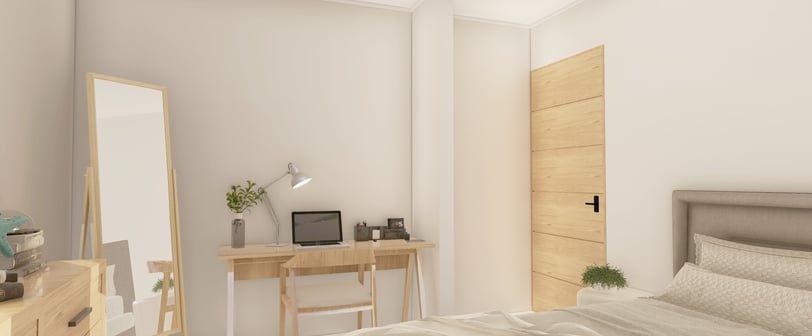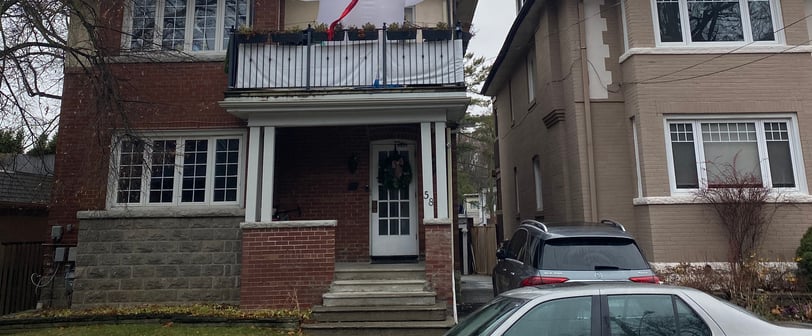Converting a Legal Basement Suite in Ontario [Checklist]
Learn the key things to check before converting a basement into a legal basement suite in Ontario with our comprehensive checklist. Ensure compliance with local regulations and the secondary dwelling project profitability.
BASEMENT SUITES
Elad Barak
9/28/20248 min read


The need for affordable housing has recently led many buyers and property owners to consider secondary units in their homes. These are also known as ADU - additional dwelling units, and include basement apartments, garden suites, laneway suites, etc. Basement conversion is one of the most popular ways to add a legal second suite. Basement ADUs can serve as rental units, in-law suites, also known as granny suites or home offices. This improves the property value and provides additional income through rental income or by offering a living space for family members.
Converting an unfinished basement into a secondary housing unit is a great way to increase the value of your property. Cities in Ontario encourage multiplex housing, as it helps address housing shortages in the province. If you're considering this opportunity for investment or family needs, there are key factors to weigh before deciding.
We use a checklist to evaluate basements for potential conversion and comply with the legal basement requirements in Ontario. It helps estimate the time, work, and cost needed for the transformation. We're now sharing this valuable tool with you.
We've listed the key considerations to ensure your basement unit complies with Ontario's local regulations and building code requirements. Just to let you know, while this guide offers practical steps, each project has its own unique considerations. We can't guarantee legal compliance for your basement unit based solely on this list. If you choose to work with our team, we’ll provide all necessary drawings and support until you secure the necessary permits. For a customized basement conversion plan tailored to your specific needs, feel free to contact us for a free consultation.
Why Building a Basement ADU?
One of the biggest advantages of converting your basement into a secondary suite is the opportunity for additional income. Whether you’re renting out the space to family members or potential tenants, a secondary unit can generate extra income that helps cover mortgage costs or other expenses. For real estate investors, a basement conversion can increase the property value and appeal to buyers looking for properties with rental potential.
Legal basement ADUs are a valuable addition to the housing stock, particularly in cities where housing shortages are common. Creating a safe place that meets local codes can provide an affordable housing option for renters while enhancing the value of your property.


Your Legal Basement Conversion Checklist
10 Items to Confirm Before You Commit
1. Ceiling Height
The first key consideration in any basement renovation is the ceiling height. For a legal basement apartment, the OBC (Ontario Building Code) requires a minimum ceiling height of 2.3 meters (7.5 feet). This is correct for living areas like the living room and kitchen. In bedrooms and bathrooms, the minimum height of the ceiling is 2.1 meters (6.9 feet). If your basement unit doesn't meet these minimum requirements, you may need to lower the floor through underpinning.
Pro Tip: Underpinning is extremely expensive and we don’t recommend choosing a property that requires this undertaking. It can significantly inflate your budget. In our checklist low ceiling is a deal breaker for a multiplex project.
2. Separate Entrance
A separate entrance is a critical requirement for any secondary unit. This provides potential tenants with independent access to the basement unit without going through the main residence. If your property doesn’t already have a separate entrance, you'll need to create one, which might involve excavation or adding a stairwell. This will almost always require creating a structural opening.
In some cases, basement stairs in the middle of the house can be connected to an exterior exit without disrupting the main floor. By adding a hallway or corridor, the stairs can link to an exit while preserving the flow of the main floor. This solution avoids major structural changes or creating a new basement entrance.
Creative solutions can help meet local zoning laws and building code requirements while minimizing project costs. This crucial step ensures compliance without breaking the bank.
Pro-tip: Many Ontario homes have basement stairs near the kitchen, which often leads to an outdoor exit. This setup makes it easier to make a path from the basement to the outside without going through other rooms.
3. Stairs
Most basements have stairs at the entrance, and in older homes, they may not meet current rules. While some stair requirements can be waived by municipalities, the minimum ceiling height of 6.5 feet must be followed. If this height isn’t met, or the stairs are too steep or too curved, you might need to change this to get it approved for the permit. Fixing stairs is usually easy, but changing the ceiling to meet the required height can be more difficult.
Pro tip: Walk up and down the stairs—if they feel awkward or uncomfortable, they likely don’t meet building regulations. If you’d prefer not to rely on your gut feeling, we offer site visits where our team can consult with you directly. Book a free consultation to learn more.
4. Egress Windows
For fire safety, each basement unit must have an egress window large enough to allow escape during an emergency. The fire code specifies that egress windows must have a clear opening of at least 0.35 square meters (3.77 sq ft). With no dimension smaller than 0.38 meters (15 inches). Many basements have a large enough wall opening but old windows that don’t fully open. Replacing just the window, without the need to open the wall, will save a lot of time and money. If your basement doesn't already have egress windows, installing them will be a critical step in the conversion process.
Pro-tip: Egress windows should be placed opposite the basement entrance. Measure them to ensure they meet the required size for code compliance.
5. Natural Light and Ventilation
Ensuring your basement unit has sufficient natural light is important for your tenants and is also a building code requirement. Natural light must enter through windows that are at least 10% of the floor area for living spaces. For bedrooms, it has to be 5%. Adding windows or enlarging existing ones can help bring in more natural light. Keep in mind that this may involve cutting into the foundation, which could increase the cost.
Proper ventilation and natural light are vital for creating a healthy living environment. Generally, many municipalities in Ontario tend to be more flexible with window size requirements in existing basements. Consulting with the local building department can help clarify their approach in such cases.
Pro-tip: Count the number of windows in your basement to ensure they meet your plan’s needs. For example, a 2-bedroom basement should have 4 windows - one for each bedroom, one for the kitchen, and one for the living room.
6. Plumbing and Sewer
Every house needs a kitchen, bathroom, and laundry. According to the Ontario Building Code, each dwelling requires access to laundry facilities. This means each unit must have its own laundry or a shared facility for multiple units.
The biggest challenge when adding these rooms is dealing with sewer under the concrete slab. The best way to save time and money is to connect to existing plumbing or place new fixtures nearby. Another factor is the size of the pipes, which may be unclear at this stage.
Let’s break down the three main cases:
7. Kitchen
Many basements already have a kitchenette that can be converted into a full kitchen. If there's already a sink in the desired location, no further plumbing is needed. Since kitchen sinks are installed at waist height, they offer flexibility (in regards to their location), allowing sewage to pass above ground if needed. Ideally, having existing plumbing in place simplifies the process, but if not, don't worry - there are various effective solutions for installing a new kitchen sink in your basement conversion.
8. Bathroom
Most basements have a half-bathroom (toilet only). Adding a shower to an existing half-bath minimizes digging. Installing a new bathroom often requires breaking through the concrete slab to access existing plumbing. While this is structurally simpler than tasks like adding windows or doors, it can still be time-consuming. Checking for the presence of existing plumbing lines near the intended bathroom location can reduce the need for extensive concrete work.
9. Laundry Facilities
In Ontario, local authorities require laundry facilities to be accessible without leaving the building. This means each unit must have its own laundry space, or there should be a shared laundry area accessible to both units. When planning, make sure there's enough space, plumbing, and electrical capacity for laundry. Many basements have laundry setups, so you’ll need to decide whether to keep them there or move them to the primary residence.
Pro-tip: Sewer is complicated to assess at this early stage, try looking for where you have pipes coming from the first floor, and if possible their size.
10. Parking Spaces
Some local jurisdictions require that you provide parking spaces for the new unit. If you think the property doesn’t have enough space to support extra parking, it's worth checking local municipality Bylaws to understand the specific rules for your area.


There are additional factors to consider when converting a basement into a self-contained living space. While important, these aren't on the checklist as they apply to all properties and won't be dealbreakers. We've added them to our comprehensive guide to keep them on your rada
HVAC and Ventilation
Proper heating, ventilation, and air conditioning (HVAC) are vital for any secondary unit. Most HVAC systems are located in basements, making it relatively easy to extend existing ductwork for the new unit. Under the OBC, two dwellings are allowed to share an HVAC system with the main dwelling. This typically involves adding a few extra ducts, which is a low-cost, low-risk addition. It’s also important to ensure sufficient ventilation (cold-air-return) in basement units.
Load-Bearing Walls
The perimeter walls of a basement also serve as foundation walls for the house. Inside the basement, you may find extra walls or columns that support the house's weight. These can be harder to spot during an initial visit but are important to identify as they may impact the design possibilities. A common tip for identifying load-bearing walls is that they often run near the centerline of the house to support the joists above. Additionally, a load-bearing wall is frequently located directly above it on the main floor. While removing a load-bearing wall is uncommon, it is usually possible to open a doorway or make minor modifications if needed. Proper identification of these walls early in the planning process is crucial to avoid structural issues.
Fire Safety
All buildings in Ontario require fire safety and separation, and basement units are no different. The reason this isn’t on the checklist, is we don’t expect to find a basement that has sufficient fire separation (as it's not required when the basement is part of the main house). Adding fire separation between dwelling units is a straightforward task which is required in almost all basement conversions. It's important, yet won’t be a factor in estimating the basement’s potential for conversion.
Permits and Legal Requirements
Before starting your ADU project, it is essential to apply for the proper permits. Building permits are required for any significant structural changes, including separate entrances, new windows, and plumbing work. Working with an architect or BCIN designer who understands the permit application process can save you time. This will ensure that the project complies with all local regulations. Remember that you need proper permits to avoid fines, delays, or even the need to undo completed work.
Your local jurisdiction will have specific legal requirements for creating a legal second suite. These might include adhering to local zoning laws, for example - ensuring the unit has enough floor space.
Conclusion
If you're planning to convert a basement into a second unit, check these key factors before buying or committing to the project. Ceiling height, separate entrance, light, egress windows, plumbing and sewer, HVAC, load-bearing walls and parking space availability matter the most. Use this checklist to assess the feasibility of your conversion project. Ensure you're making an informed decision about the property. This list will help you evaluate the potential for a successful basement conversion. Feel free to contact us for more information.


